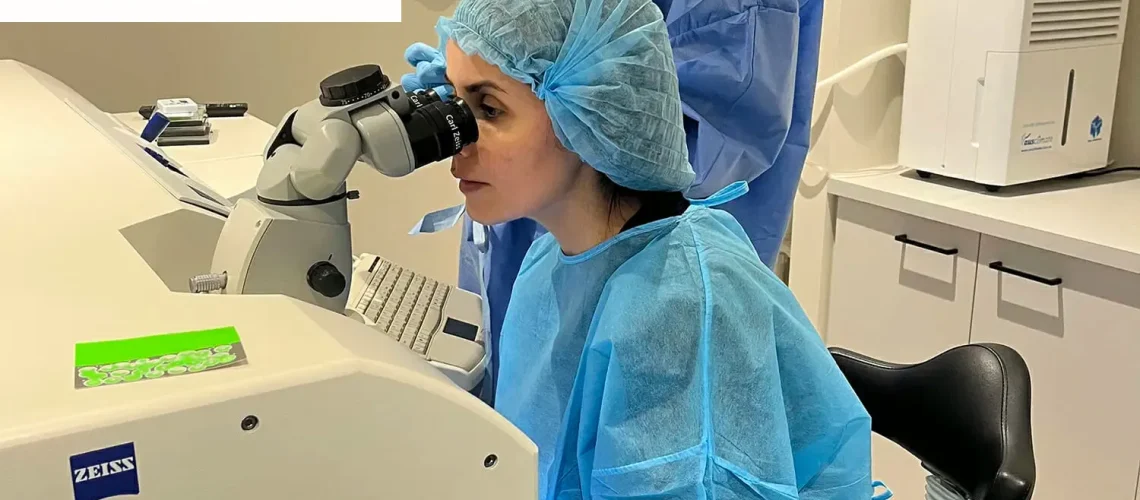Optometrists attending a wet lab at Bondi Eye Doctors, part of SMS Healthcare, have been given a unique opportunity to perform laser assisted lenticule extraction (LALEX) surgery using Johnson and Johnson Vision’s new Elita femtosecond laser platform.
Leveraging a fast and ultra-precise laser pulse, the Elita is used to perform LALEX, branded by Johnson and Johnson as SILK – smooth incision lenticule keratomileusis. The technology follows in the footsteps of the Zeiss femtosecond laser platform which has successfully been used to perform SMILE (small incision lenticule extraction) for over a decade.
Like other forms of LALEX surgery (SMILE), SILK can be used to correct myopia, with or without astigmatism.
At the Bondi Eye Doctors wet lab, ophthalmologist Dr Patrick Versace, with Angela Chung from Johnson and Johnson Vision Care, calmly guided optometrists kitted out in surgical gowns, hats and boots through the SILK procedure, which they performed on porcine eyes.
Using joystick controls and a touch screen, optometrists were asked to attach a suction ring to the eye then lock the ring onto the laser. Then they proceeded to make a lenticule, loosen it from the posterior and anterior planes of the corneal stroma, and remove it.
Dr Versace said an advantage of the SILK technology over SMILE is that once the eye is attached to the laser, the lenticule can be moved into different positions.
“With this new platform, once you get to this stage we can align (the lenticule) better with the visual access… so if a patient has an astigmatism, I can rotate the lenticule to better match the axis of the astigmatism.”
He observed that SILK better maintains corneal strength and achieves a very smooth corneal interface, making lenticular removal extremely easy and recovery fast.
While SILK is the new kid on the block in laser lenticule refractive surgery, Dr Versace emphasized that this does not mean it is the procedure of choice for all patients.
LALEX, LASIK, photorefractive keratectomy (PRK) and implantable collamer lens (ICL) procedures all have their place. It just depends on the patient, he said.
Forks in Decision Making
During an informative lecture on the same evening, refractive and corneal specialist Dr Tanya Trinh delved into more detail about the options for refractive surgery and the “forks” in the decision-making process.
Dr Trinh observed that every patient’s eye is unique, as is the way they use their vision and their expectations for vision post-laser refraction, all of which contribute to the approach taken.
She noted that patients who come with firm preconceived ideas about the laser procedure they should have, or the intraocular lens they should have implanted in the case of cataract surgery, can be the most challenging, as their eye may not actually be suitable for that product or service.
The only way to determine the best procedure for each patient is through a thorough ocular examination and discussion of their age, functional needs, and desires to match them with the best technology type.
“You might refer two patients with a seemingly identical refraction, and I may recommend a different procedure for each of those patients – PRK for one, LALEX for another, LASIK or ICL… There’s no one size fits all method… As for results, even though refractions might be very consistent, everyone’s baseline biology and their healing responses – which we cannot control – are different. Understanding this is crucial to informed consent and setting expectations,” she said.
Dr Trinh said assessing a patient’s personality traits are also incredibly relevant for ophthalmologists when making decisions “because these procedures are not reversible”, and not all technologies will suit all personality types.
Taking Time
“In some ways, the marketing around refractive surgery has done us a disservice by creating the perception that it’s a quick and therefore simple procedure, like a teeth-whitening process – and that therefore everything has to be expedited.
However, the reality is that vision loss is what people fear most, so we absolutely need to take the time to make sure we’re doing things properly – that we are taking the utmost care, as well as a personalised approach.”
Dr Trinh’s presentation was supported by a presentation by orthoptist Sri Chandrasekaran who described how orthoptists at Bondi Eye Doctors use the Pentacam to measure each patient’s tomography prior to them seeing the ophthalmologist. She said the comprehensive information gathered from the Pentacam is invaluable in guiding the refractive surgery procedure and IOL selection, as well as patient education.
About SMS Healthcare
SMS Healthcare is a private healthcare provider focusing on facilitating and streamlining patient care through multidisciplinary teams, short-stay hospitals and integration of healthcare services. The company has a national footprint and comprises primary care, diagnostic care, specialist care, day surgery and short-stay hospitals across multiple healthcare disciplines. SMS Healthcare focuses on achieving operational efficiencies and streamlining the delivery of healthcare to support connected patient care.


